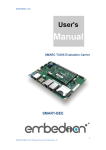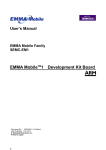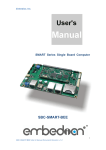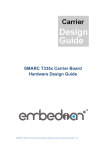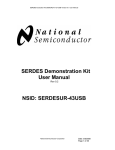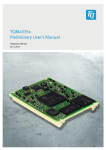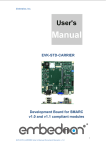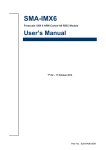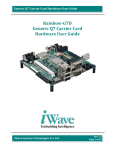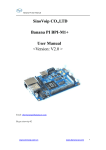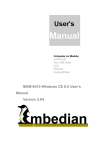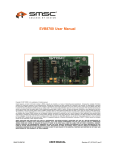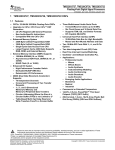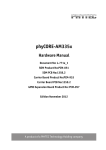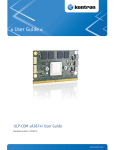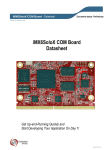Download SMARC T335x - Embedian Inc, The leading ARM Based Embedded
Transcript
Embedian, Inc. SMARC Computer on Module TI Sitara AM335x Cortex A8 Parallel LCD 18/24 bits 3 x COM Ports 1 x SDHC 1 x USB Host 2.0, 1 x USB OTG 2 x 10/100Mbps Ethernet CAN Bus, 2 x SPIs, 3 x I2C SMARC T335x 1 SMARC T335x Computer on Module User’s Manual v.1.02 Embedian, Inc. 2 SMARC T335x Computer on Module User’s Manual v.1.02 Embedian, Inc. Revision History Revision Date Changes from Previous Revision 1.0 2013/4/16 Initial Release 1.01 2013/5/06 1. Correct Boot Configuration 2. Correct Debugging Port from SER1 to SER3 3. Add module EEPROM Format Information 1.02 1. Correct the rtc-s35390a i2c address from 0x34 to 0x30 3 SMARC T335x Computer on Module User’s Manual v.1.02 Embedian, Inc. USER INFORMATION About This Manual This document provides information about products from EMBEDIAN, INC. No warranty of suitability, purpose, or fitness is implied. While every attempt has been made to ensure that the information in this document is accurate, the information contained within is supplied “as-is” and is subject to change without notice. For the circuits, descriptions and tables indicated, EMBEDIAN assumes no responsibility as far as patents or other rights of third parties are concerned. Copyright Notice Copyright © 2013 EMBEDIAN, INC.. All rights reserved. No part of this manual may be reproduced, transmitted, transcribed, stored in a retrieval system, or translated into any language or computer language, in any form or by any means (electronic, mechanical, photocopying, recording, or otherwise), without the express written permission of EMBEDIAN. Trademarks The following lists the trademarks of components used in this board. ARM is a registered trademark of ARM Limited. Android is a registered trademark of Google Linux is a registered trademark of Linus Torvalds. WinCE is a registered trademark of Microsoft TI is a registered trademark of Texas Instruments All other products and trademarks mentioned in this manual are trademarks of their respective owners. Standards EMBEDIAN is ISO 9001:2008 and ISO14001-certified manufacturer. SMARC is an SGET standard for ARM computer on module. Warranty This EMBEDIAN product is warranted against defects in material and workmanship for the warranty period from the date of shipment. During the warranty period, EMBEDIAN will at its discretion, decide to repair or replace defective products. Within the warranty period, the repair of products is free of charge as long as warranty conditions are observed. The warranty does not apply to defects resulting from improper or inadequate maintenance or handling by the buyer, unauthorized modification or misuse, operation outside of the product’s environmental specifications or improper installation or maintenance. 4 SMARC T335x Computer on Module User’s Manual v.1.02 Embedian, Inc. EMBEDIAN will not be responsible for any defects or damages to other products not supplied by EMBEDIAN that are caused by a faulty EMBEDIAN product. Technical Support Technicians and engineers from EMBEDIAN and/or its subsidiaries and official distributors are available for technical support. We are committed to making our product easy to use and will help you use our products in your systems. Before contacting EMBEDIAN technical support, please consult our Web site for the latest product documentation, utilities, and drivers. If the information does not help solve the problem, contact us by e-mail or telephone. 5 SMARC T335x Computer on Module User’s Manual v.1.02 Embedian, Inc. Table of Contents CHAPTER 1 INTRODUCTION .............................................................................................................. 10 1.1 FEATURES AND FUNCTIONALITY ............................................................................................... 10 1.2 MODULE VARIANT .......................................................................................................................... 11 1.3 BLOCK DIAGRAM ........................................................................................................................... 12 1.4 SOFTWARE SUPPORT / HARDWARE ABSTRACTION.................................................................. 13 1.5 DOCUMENT AND STANDARD REFERENCES.............................................................................. 13 CHAPTER 2 SPECIFICATIONS ............................................................................................................ 17 2.1 SMARC T335X GENERAL FUNCTIONS ......................................................................................... 17 2.2 SMARC T335X DEBUG.................................................................................................................... 50 2.3 MECHANICAL SPECIFICATIONS .................................................................................................. 50 2.4 ELECTRICAL SPECIFICATIONS .................................................................................................... 56 2.5 ENVIRONMENTAL SPECIFICATIONS ........................................................................................... 59 CHAPTER 3 CONNECTOR PINOUT .................................................................................................... 61 3.1 SMARC T335X CONNECTOR PIN MAPPING................................................................................ 61 CHAPTER 4 HANDSHAKING BETWEEN SMARC T335X MODULE AND CARRIER ....................... 86 4.1 SMARC T335X MODULE POWER .................................................................................................. 86 4.2 TERMINATIONS ............................................................................................................................... 90 4.3 BOOT SELECT ................................................................................................................................. 93 6 SMARC T335x Computer on Module User’s Manual v.1.02 Embedian, Inc. Using this Manual This guide provides information about the Embedian SMARC (formerly ULP-COM) T335X for TI AM335x embedded SMARC core module family. Conventions used in this guide This table describes the typographic conventions used in this guide: This Convention Is used for Italic type Emphasis, new terms, variables, and document titles. Filenames, pathnames, and code examples. monospaced type Embedian Information Document Updates Please always check the product specific section on the Embedian support website at www.embedian.com/ for the most current revision of this document. Contact Information For more information about your Embedian products, or for customer service and technical support, contact Embedian directly. To contact Embedian by Use Mail Embedian, Inc. 4F-7. 432 Keelung Rd. Sec. 1, Taipei 11051, Taiwan World Wide Web http://www.embedian.com/ Telephone + 886 2 2722 3291 Additional Resources Please also refer to the most recent TI AM335x processor reference manual 7 SMARC T335x Computer on Module User’s Manual v.1.02 Embedian, Inc. and related documentation for additional information. 8 SMARC T335x Computer on Module User’s Manual v.1.02 Embedian, Inc. Introduction This Chapter gives background information on the SMARC T335X Section include: Features and Functionality Module Variant Block diagram Software Support / Hardware Abstraction Module Variant Document and Standard References 9 SMARC T335x Computer on Module User’s Manual v.1.02 Embedian, Inc. Chapter 1 Introduction The SMARC® (Smart Mobility ARChitecture, formerly ULP-COM, Ultra Low Power – Computer on Module) T335x is a versatile small form factor Computer-On-Module that requires low power and provides high performance at low cost. The module connector has 314 edge fingers that mate with a low profile 314 pin 0.5mm pitch right angle connector (this connector is sometimes identified as an 321 pin connector, but 7 pins are lost to the key). Featuring TI’s AM335x System-on-Chip, Embedian’s SMARC T335X offers Parallel LCD, two 10/100Mbps Ethernet, SDHC, USB 2.0, USB OTG, three UARTs support and many peripheral interfaces in a cost effective, low power, miniature package. Embedian’s SMARC T335X thin and robust design makes it an ideal building block for reliable system design. The module is the ideal choice for a broad range of target markets including HVAC Building and Control Systems Fire Alarms Smart Grid and Smart Metering E-Bike HMI/ In-Home Display Smart Toll Systems Connected Vending Machines Fiscal Printer/ Weighing Scales/ Currency Counter And more Complete and cost-efficient Embedian evaluation kits for Ubuntu 12.04, Android ICS and Microsoft Windows Embedded Compact 7 allow immediate and professional embedded product development with dramatically reduced design risk and time-to-market. 1.1 Features and Functionality The SMARC T335X module is based on the AM335x processor from Texas Instruments. This processor offers a high number of interfaces. Most of these interfaces are multiplexed and are not available simultaneously. The module has the following features: SMARC (ULP-COM) compliant in an 82mm x 50mm form factor. Processor: TI Sitara AM335x ARM Cortex-A8 up to 1GHz Memory: Onboard 4GB eMMC Flash and 4MB SPI NOR Flash Onboard 512MB DDR3 (606Mhz) 10 SMARC T335x Computer on Module User’s Manual v.1.02 Embedian, Inc. Networking: 2 x 10/100 Mbps Ethernet Display: Parallel LCD 18-bit/24-bit Expansion: 1 x SDHC/SDIO, 1 x USB 2.0 Host USB: 1 x USB 2.0 Host, 1 x USB 2.0 OTG A single 4KB EEPROM is provided on I2C0 that holds the board information. This information includes board name, serial number, and revision information. Additional Interface: 3 x UARTs 2 x SPI 3 x I2C 1 x I2S 1 x CAN Bus 1 x PWM 12 x GPIOs 4 x ADCs WDT SW Support: Linux (Ubuntu 12.04), Android ICS, Windows Embedded Compact 7 Power Consumption: 1.5 Watts Typical Thermal: o o Normal Temperature: 0 C ~ 60 C o o Industrial Temperature: -40 ~85 C Power Supply 3V to 5.25V (single 5V is recommended in non-battery operation) 3.3V module IO support 1.2 Module Variant The SMARC T335X module is available with various options based on processors in this family from Texas Instruments. For example, if people would like to use Sitara AM3354 from Texas Instruments, you can order SMARC T3354. 11 SMARC T335x Computer on Module User’s Manual v.1.02 Embedian, Inc. 1.3 Block Diagram The following diagram illustrates the system organization of the SMARC T335X. Arrows indicate direction of control and not necessarily signal flow. Figure 1: SMARC T335X Block Diagram Details for this diagram will be explained in the following chapters. 12 SMARC T335x Computer on Module User’s Manual v.1.02 Embedian, Inc. 1.4 Software Support / Hardware Abstraction The Embedian SMARC T335X Module is supported by Embedian BSPs (Board Support Package). The first SMARC T335X BSP targets Linux (Ubuntu 12.04 LTS) and Android support. BSPs for other operating systems are planned. Check with your Embedian contact for the latest BSPs. This manual goes into a lot of detail on I/O particulars – information is provided on exactly how the various SMARC edge fingers tie into the TI SoC and to other Module hardware. This is provided for reference and context. Almost all of the I/O particulars are covered and abstracted in the BSP and it should generally not be necessary for users to deal with I/O at the register level. 1.5 Document and Standard References 1.5.1. External Industry Standard Documents eMMC (Embedded Multi-Media Card) the eMMC electrical standard is defined by JEDEC JESD84-B45 and the mechanical standard by JESD84-C44 (www.jedec.org). The I2C Specification, Version 2.1, January 2000, Philips Semiconductor (now NXP) (www.nxp.com). I2S Bus Specification, Feb. 1986 and Revised June 5, 1996, Philips Semiconductor (now NXP) (www.nxp.com). JTAG (Joint Test Action Group defined by IEEE 1149.1-2001 - IEEE Standard Test Access Port and Boundary Scan Architecture (www.ieee.org). MXM3 Graphics Module Mobile PCI Express Module Electromechanical Specification, Version 3.0, Revision 1.1, © 2009 NVIDIA Corporation (www.mxm-sig.org). PICMG® EEEP Embedded EEPROM Specification, Rev. 1.0, August 2010 (www.picmg.org). SD Specifications Part 1 Physical Layer Simplified Specification, Version 3.01, May 18, 2010, © 2010 SD Group and SD Card Association (Secure Digital) (www.sdcard.org). SPI Bus – “Serial Peripheral Interface” - de-facto serial interface standard defined by Motorola. A good description may be found on Wikipedia (http://en.wikipedia.org/wiki/Serial_Peripheral_Interface_Bus). USB Specifications (www.usb.org). 13 SMARC T335x Computer on Module User’s Manual v.1.02 Embedian, Inc. 1.5.2. SGET Documents SMARC_Hardware_Specification_V1p0, version 1.0, December 20, 2012. 1.5.3. Embedian Documents The following documents are listed for reference. The Module schematic is not usually available outside of Embedian, without special permission. The other schematics may be available, under NDA or otherwise. Contact your Embedian representative for more information. The SMARC T335x Evaluation Carrier Board Schematic is particularly useful as an example of the implementation of various interfaces on a Carrier board. SMARC_T335x Evaluation Carrier Board Schematic, PDF and OrCAD format SMARC_T335x Evaluation Carrier Board User’s Manual SMARC_T335x Carrier Board Hardware Design Guide SMARC_T335x Carrier Board Hardware Layout Guide SMARC_T335x User’s Manual SMARC_T335X Schematic Checklist 1.5.4. TI Documents AM335x ARM Cortex-A8 Microprocessors (MPUs), April 15 2013 (rev. F) AM335x Schematic Checklist, Oct 31 2011 AM335x ARM Cortex-A8 Microprocessors (MPUs) Technical References Manual, April 15 2013 (rev. H) AM335x Power Consumption Summary, Oct 31 2011 1.5.5. TI Development Tools Pin Mux Utility for ARM® Microprocessors Power Estimation Tool (PET) 1.5.6. TI Software Documents LINUXEZSDK-AM335x ANDROIDDEVKIT-JB-AM335x 14 SMARC T335x Computer on Module User’s Manual v.1.02 Embedian, Inc. 1.5.7. Embedian Software Documents Embedian Linux BSP for SMARC T335X Module Embedian Android BSP for SMARC T335X Module Embedian Linux BSP User’s Guide Embedian Android BSP User’s Guide 1.5.8. TI Design Network Beaglebone Adeneo Embedded (Windows Embedded Compact 7) Nucleus QNX 15 SMARC T335x Computer on Module User’s Manual v.1.02 Embedian, Inc. Specifications This Chapter provides SMARC T335X specifications. Section include: SMARC T335X General Functions SMARC T335X Debug Mechanical Specifications Electrical Specification Environment Specification 16 SMARC T335x Computer on Module User’s Manual v.1.02 Embedian, Inc. Chapter 2 Specifications 2.1 SMARC T335X General Functions 2.1.1. SMARC T335X Feature Set This section lists the complete feature set supported by the SMARC T335X module. SMARC Feature Specification SMARC Specification Maximum Number Possible SMARC T335X Feature Support SMARC T335X Feature Support Instances LVDS Display Support 1 No (transmitter on carrier) 0 Parallel LCD Support 1 Yes 1 (18/24 bits) HDMI Display Support 1 No 0 CSI Camera Support (Dual and Quad lanes) 2 No 0 Parallel Camera Support 2 No 0 USB Interface 3 Yes 2 PCIe Interface 3 No 0 SATA Interface 1 No 0 GbE Interface 1 10/100Mbps 1 SDIO Interface 1 Yes 1 SDMMC Interface 1 No (4GB eMMC on module) 0 SPI Interface 2 Yes 2 I2S Interface 3 Yes 1 I2C Interface 5 Yes 3 Serial 4 Yes 3 CAN 2 Yes 1 17 SMARC T335x Computer on Module User’s Manual v.1.02 Embedian, Inc. SMARC Feature Specification SMARC Specification Maximum Number Possible SMARC T335X Feature Support AFB Yes I/O Voltage (1.8V) Level Support No I/O Voltage (3.3V) Level Support Yes SMARC T335X Feature Support Instances 2nd LAN and resistive touch 2.1.2. Form Factor The SMARC T335X module complies with the SMARC General Specification module size requirements in an 82mm x 50mm form factor. 2.1.3. CPU The SMARC T335X implements TI’s AM335x ARM processor. Up to 1GHz ARM Cortex-A8 Microprocessor 1 Cache 32 KB Instruction cache (I-Cache) and 32 KB Data cache (D-Cache) with Single-Error Detection (parity) 256KB of L2 Cache with Error Correcting - Emulation and Debug Code (ECC) 176KB of On-Chip Boot ROM 64KB of Dedicated RAM SGX530 graphic engine Programmable Real-Time Unit and Industrial - Dedicated Input Pin (EXT_WAKEUP) for Communication Subsystem (PRU-ICSS) Supports protocols such as EtherCAT®, PROFIBUS, PROFINET, EtherNet/IP™, and more. 15mm x 15mm (ZCZ) package size o o Optional industrial temperature rage -40 C ~ 85 C Note: SGX530 graphics support for AM3354 and AM3358 processor (pin-to-pin). 18 SMARC T335x Computer on Module User’s Manual v.1.02 Embedian, Inc. 2.1.4. Module Memory The SMARC T335X module supports 512MB DDR3 memory. Other variations would include alternative eMMC options, including possibly no on-Module eMMC. Check with your Embedian contact or on the Embedian web site for updated information. 2.1.5. Onboard Storage The SMARC T335X module supports a 4GB eMMC flash memory device, 4MB SPI NOR flash and a 32Kb I2C serial EEPROM on the Module I2C_PM (I2C0) bus. The device used is an On Semiconductor 24C32 equivalent. The Module serial EEPROM is intended to retain Module parameter information, including a module serial number. The Module serial EEPROM data structure conforms to the PICMG® EEEP Embedded EEPROM Specification.). The onboard 4MB SPI NOR flash that can be used as SPI boot media or for users to store secure data. 2.1.6. Clocks A 32.768 KHz clock is required for the TM335x CPU RTC (Real Time Clock) and I2C RTC slave device. The TI AM335x CPU is provided with a 24 MHz clock using a crystal in normal oscillation mode (On-chip Oscillator). The SMSC LAN8720A PHY is provided with a 25 Mhz clock using a crystal in normal oscillation mode. 2.1.7. Parallel LCD Interface The TI AM335x parallel 24 bit LCD interface is brought to the Module edge connector. The interface runs at the 3.3V Module I/O voltage. This voltage swing may be used directly with 3.3V capable Carrier Board LVDS transmitters, such as the TI SN75LVDS83B. The 3.3V signaling is suitable for direct connection to a parallel flat panel in most cases. Generally speaking, larger parallel LCD panels are likely to use 3.3V or 5V signaling. If LCD panels use 5V signaling, a set of voltage translators / buffers would be needed on the Carrier. 19 SMARC T335x Computer on Module User’s Manual v.1.02 Embedian, Inc. Figure 2: SMARC T335X Block Diagram The mapping of the TI AM335x parallel LCD pins to the SMARC edge connector is shown in the table below. Note that the TI Sitara AM335x pin names and the SMARC pin names have different assumptions about color mappings, which can make things confusing. Basically, TI Sitara AM335x processor maps the 18 bits or R, G, B for 6 bit color depth to LCD_DATA[17:0]. For Sitara AM335x, the extra bits used for a 24 bit color implementation come out on TI LCD_DATA[23:18]. Since 18-bit configuration and 24-bit configuration use the same MSB signals, we can say 18-bit configuration is higher bits subset 24-bit configuration from the hardware point of view. The SMARC has a different convention: Red is LCD_D[23:16]; Blue is LCD_D[15:8] and Green is LCD_D[7:0]. For 24 bit implementations, all bits are used. For 18 bit implementations, in SMARC, the least significant bits (Red LCD_D[17:16], Green LCD_D[9:8], Blue LCD_D[1:0]) are dropped. 20 SMARC T335x Computer on Module User’s Manual v.1.02 Embedian, Inc. TI AM335x CPU SMARC T335X Edge Golden Finger Net Names (Carrier Board) Color 24-bit Color Map Mode Pin Name Pin# Pin Name T1 Mode0 LCD_DATA4 S118 LCD_D23 (MSB) LCD_D23 R7 R4 Mode0 LCD_DATA3 S117 LCD_D22 LCD_D22 R6 R3 Mode0 LCD_DATA2 S116 LCD_D21 LCD_D21 R5 R2 Mode0 LCD_DATA1 S115 LCD_D20 LCD_D20 R1 Mode0 LCD_DATA0 S114 LCD_D19 LCD_D19 R3 U13 Mode1 LCD_DATA16 S113 LCD_D18 LCD_D18 R2 R12 Mode1 LCD_DATA18 S112 LCD_D17 LCD_D17 R1 T11 Mode1 LCD_DATA21 S111 LCD_D16 (LSB) LCD_D16 R0 U3 Mode0 LCD_DATA10 S109 LCD_D15 (MSB) LCD_D15 G7 U2 Mode0 LCD_DATA9 S108 LCD_D14 LCD_D14 G6 U1 Mode0 LCD_DATA8 S107 LCD_D13 LCD_D13 G5 T4 Mode0 LCD_DATA7 S106 LCD_D12 LCD_D12 T3 Mode0 LCD_DATA6 S105 LCD_D11 LCD_D11 T2 Mode0 LCD_DATA5 S104 LCD_D10 LCD_D10 G2 T12 Mode1 LCD_DATA19 S103 LCD_D9 LCD_D9 G1 T10 Mode1 LCD_DATA22 S102 LCD_D8 (LSB) LCD_D8 G0 T5 Mode0 LCD_DATA15 S100 LCD_D7 (MSB) LCD_D7 B7 V4 Mode0 LCD_DATA14 S99 LCD_D6 LCD_D6 B6 V3 Mode0 LCD_DATA13 S98 LCD_D5 LCD_D5 B5 V2 Mode0 LCD_DATA12 S97 LCD_D4 LCD_D4 U4 Mode0 LCD_DATA11 S96 LCD_D3 LCD_D3 B3 V13 Mode0 LCD_DATA17 S95 LCD_D2 LCD_D2 B2 U12 Mode1 LCD_DATA20 S94 LCD_D1 LCD_D1 B1 U10 Mode1 LCD_DATA23 S93 LCD_D0 (LSB) LCD_D0 B0 BLUE GREEN RED Ball R4 G4 G3 B4 21 SMARC T335x Computer on Module User’s Manual v.1.02 Embedian, Inc. TI AM335x CPU SMARC T335X Edge Golden Finger Ball Mode Pin Name Pin# V5 Mode0 LCD_PCLK S123 LCD_PCK R6 Mode0 LCD_AC_BIAS_ EN S120 R5 Mode0 LCD_HSYNC U5 Mode0 LCD_VSYNC Net Names Color 24-bit Color Map Pin Name LCD_PCLK LCD_DE LCD_DE S122 LCD_HS LCD_HSYNC S121 LCD_VS LCD_VSYNC To use displays which require fewer bits (e.g. 18 or 16 bit displays), simply do not connect the bottom n LSBs for each color, where n is the number of signals that are not required for a specific color. For instance, to connect an 18 bit display, R0, R1, G0, G1, B0 and B1 will remain unused, and R2, G2 and B2 become the LSBs for this configuration. 22 SMARC T335x Computer on Module User’s Manual v.1.02 Embedian, Inc. 2.1.8. USB Interface The Embedian SMARC T335X module supports two USB ports (USB 0:1). Per the SMARC specification, the module supports a USB “On-The-Go” (OTG) port capable of functioning either as a client or host device, on the SMARC USB0 port. The SMARC T335X module also supports one additional USB2.0 host ports, on SMARC USB1. USB interface signals are exposed on the SMARC T335X edge connector as shown below: TI AM335x CPU Ball Mode Pin Name SMARC T335X Edge Golden Finger Pin# Net Names Note Pin Name USB0 Port (OTG) N17 Mode0 USB0_DP P60 USB0+ USB0+ N18 Mode0 USB0_DM P61 USB0‐ USB0‐ F16 Mode0 USB0DRVVBUS P62 USB0_EN_OC# P15 Mode0 USB0_VBUS P63 P16 Mode0 USB0_ID P64 USB0_EN_OC# USB0_VBUS_DET 5V tolerant USB0 port data pair USB Port0 power enable/over current indication signal USB host power detection, when this port is used as a device. USB0_OTG_ID USB0_ID USB OTG ID input, active high USB1 port data pair USB1 Port (Host 2.0) R18 Mdde0 USB1_DP P65 USB1+ USB1_DP R17 Mode0 USB1_DM P66 USB1‐ USB1_DM F15 Mode0 USB1DRVVBUS P67 USB1_EN_OC# USB1_EN_OC# USB Port0 power enable/over current indication signal 23 SMARC T335x Computer on Module User’s Manual v.1.02 Embedian, Inc. The SMARC Hardware specification defines USBx_EN_OC# (where x is 0 or 1 for use with USB0 or USB1) pins as multifunction pins to use for power enable of USBx ports, as well as for over current indication. The SMARC T335X complies with this definition. These nets are provided with a 10k pull up resistors on the Module. The SMARC T335X Module USB power enable and over current indication logic implementation is shown in the following block diagram. There are 10K pull-up resistors on the Module on the SMARC USBx_EN_OC# lines. Outputs driving the USBx_EN_OC# lines are open-drain. The Carrier board USB power switch, if present, is enabled by virtue of the 10K Module pull-up to 3.3V. Figure 3. External USB Port Power Distribution Logic Implementation 24 SMARC T335x Computer on Module User’s Manual v.1.02 Embedian, Inc. Power distribution for external USB plug-in peripherals (USB memory sticks, cameras, keyboards, mice, etc.) is typically handled by USB power switches such as the Texas Instruments TPS2052B, Micrel MIC2026-1 or similar devices on the Carrier board. The Enable pin on the Carrier board USB power switch must be active – high and the Over-Current pin (OC#) must be open drain, active low (these are commonly available). No pull-up is required on the USB power switch Enable or OC# line; they are tied together on the Carrier and fed to the Module USBx_EN_OC# pin. The pull-up is on the Module. 25 SMARC T335x Computer on Module User’s Manual v.1.02 Embedian, Inc. Figure 4. USB Power Distribution Implementation on Carrier 2.1.9. Fast Ethernet Controller (10/100Mbps) Interface Sitara AM335x CPU offers a high number of interfaces include, but most of these interfaces are multiplexed and are not available simultaneously. This processor can be configured as one Gigabit LAN (MAC) or two 10/100Mpbs LAN (MAC). The SMARC T335X module supports two fast Ethernet (10/100Mbps) interfaces. Two fast Ethernet controller interfaces are 26 SMARC T335x Computer on Module User’s Manual v.1.02 Embedian, Inc. accomplished by using the low-power SMSC LAN8720A physical layer (PHY) transceiver with variable I/O voltage that is compliant with the IEEE 802.3-2005 standards. The LAN8720A supports communication with an Ethernet MAC via a standard RMII interface. This is diagrammed below. Figure 5: Fast Ethernet Connection from Sitara AM335x to SMSC LAN8720A 27 SMARC T335x Computer on Module User’s Manual v.1.02 Embedian, Inc. Sitara AM335x and SMSC LAN8720A implementation is shown in the following table: TI AM335x CPU Ball SMSC LAN8720A Pin# Net Names Note Mode Pin Name Pin Name M17 Mode0 MDIO_DATA 12 MDIO MDIO_DATA Serial Management Interface data input/output M18 Mode0 MDIO_CLK 13 MDC MDIO_CLK Serial Management Interface clock L15 Mode1 RMII1_RXD1 7 RXD1 RMII1_RXD1 Bit 1 of the 2 data bits that are sent by the transceiver on the receive path. M16 Mode1 RMII1_RXD0 8 RXD0 RMII1_RXD0 Bit 0 of the 2 data bits that are sent by the transceiver on the receive path. H18 Mode0 RMII1_REFCLK 14 J15 Mode1 RMII1_RXER J16 Mode1 K17 K16 LAN1 nINT/REFCLKO RMII1_RXCLK Reference clock 10 RXER/PHYAD0 RMII1_RXER RMII1_TXEN 16 TXEN RMII1_TXEN This signal is asserted to indicate that an error was detected somewhere in the frame presently being transferred from the transceiver. Indicates that valid transmission data is present on TXD[1:0]. Mode1 RMII1_TXD0 17 TXD0 RMII1_TXD0 The MAC transmits data to the transceiver using this signal. Mode1 RMII1_TXD1 18 TXD1 RMII1_TXD1 The MAC transmits data to the transceiver using this signal. 28 SMARC T335x Computer on Module User’s Manual v.1.02 Embedian, Inc. TI AM335x CPU Ball SMSC LAN8720A Pin# Net Names Note Mode Pin Name Pin Name Mode1 RMII1_CRS_DV 11 CRS_DV RMII1_CRS_DV This signal is asserted to indicate the receive medium is non-idle. When a 10BASE-T packet is received, CRS_DV is asserted, but RXD[1:0] is held low until the SFD byte (10101011) is received. M17 Mode0 MDIO_DATA 12 MDIO MDIO_DATA Serial Management Interface data input/output M18 Mode0 MDIO_CLK 13 MDC MDIO_CLK Serial Management Interface clock T16 Mode3 RMII2_RXD1 7 RXD1 RMII2_RXD1 Bit 1 of the 2 data bits that are sent by the transceiver on the receive path. V17 Mode3 RMII2_RXD0 8 RXD0 RMII2_RXD0 Bit 0 of the 2 data bits that are sent by the transceiver on the receive path. H16 Mode1 RMII2_REFCLK 14 U17 Mode3 RMII2_RXER R13 Mode3 RMII2_TXEN LAN1 H17 LAN2 nINT/REFCLKO RMII2_RXCLK Reference clock 10 RXER/PHYAD0 RMII2_RXER 16 TXEN RMII2_TXEN This signal is asserted to indicate that an error was detected somewhere in the frame presently being transferred from the transceiver. Indicates that valid transmission data is present on TXD[1:0]. 29 SMARC T335x Computer on Module User’s Manual v.1.02 Embedian, Inc. TI AM335x CPU Ball SMSC LAN8720A Pin # Net Names Note Mode Pin Name Pin Name V15 Mode3 RMII2_TXD0 17 TXD0 RMII2_TXD0 The MAC transmits data to the transceiver using this signal. R14 Mode3 RMII2_TXD1 18 TXD1 RMII2_TXD1 The MAC transmits data to the transceiver using this signal. T17 Mode3 RMII2_CRS_DV 11 CRS_DV RMII2_CRS_DV This signal is asserted to indicate the receive medium is non-idle. When a 10BASE-T packet is received, CRS_DV is asserted, but RXD[1:0] is held low until the SFD byte (10101011) is received. LAN2 One fast Ethernet port is exposed to GbE port in SMARC golden finger edge connector, the other one is exposed to AFB (Alternative Function Block) pins that has second GbE port definition in SMARC specification. The pin-outs of fast Ethernet (10/100Mbps) are a subset of GbE that defines in SMARC spec. The path from LAN8720A to the golden finger edge connector is show in the following figure. 30 SMARC T335x Computer on Module User’s Manual v.1.02 Embedian, Inc. Figure 6: Fast Ethernet Connection from SMSC LAN8720A to golden finger edge connector 31 SMARC T335x Computer on Module User’s Manual v.1.02 Embedian, Inc. SMSC LAN8720A Pin Pin Name Golden Finger Edge Connector Pin# Net Names Note Pin Name LAN1 21 TXP P30 GbE_MDI0+ GBE_MDI0+ Differential Transmit/Receive Positive Channel 0 20 TXN P29 GbE_MDI0‐ GBE_MDI0‐ Differential Transmit/Receive Negative Channel 0 1,19 VDD1A, VDD2A P28 GbE_CTREF GBE_CTREF Center tap reference voltage 23 RXP P27 GbE_MDI1+ GBE_MDI1+ Differential Transmit/Receive Positive Channel 1 22 RXN P26 GbE_MDI1‐ GBE_MDI1‐ Differential Transmit/Receive Negative Channel 1 3 LED1/REGOFF P25 GbE_LINK_ACT# GBE_LINK_ACT# Link / Activity Indication LED Driven low on Link (10, 100 or 1000 mbps) Blinks on Activity Could be able to sink 24mA or more Carrier LED current 2 LED2/nINTSEL P21 GbE_LINK100# GBE_LINK100# Link Speed Indication LED for 100Mbps Could be able to sink 24mA or more Carrier LED current 32 SMARC T335x Computer on Module User’s Manual v.1.02 Embedian, Inc. SMSC LAN8720A Pin Pin Name Golden Finger Edge Connector Pin# Net Names Note Pin Name LAN2 21 TXP S62 AFB_DIFF0+ GBE1_MDI0+ Differential Transmit/Receive Positive Channel 0 20 TXN S63 AFB_DIFF0‐ GBE1_MDI0‐ Differential Transmit/Receive Negative Channel 0 1,19 VDD1A, VDD2A S17 AFB0_OUT GBE1_CTREF Center tap reference voltage 23 RXP S65 AFB_DIFF1+ GBE1_MDI1+ Differential Transmit/Receive Positive Channel 1 22 RXN S66 AFB_DIFF1‐ GBE1_MDI1‐ Differential Transmit/Receive Negative Channel 1 3 LED1/REGOFF S55 AFB8_PTIO GBE1_LINK_ACK# Link / Activity Indication LED Driven low on Link (10, 100 or 1000 mbps) Blinks on Activity Could be able to sink 24mA or more Carrier LED current 2 LED2/nINTSEL S23 AFB6_PTIO GBE1_LINK100# Link Speed Indication LED for 100Mbps Could be able to sink 24mA or more Carrier LED current Caution: Due to SMARC T335x support Fast Ethernet instead of Gigabit LAN, GBE_MDI2 (+ and -) and GBE_MDI3 (+ and -) are not connected to the golden finger connector. 33 SMARC T335x Computer on Module User’s Manual v.1.02 Embedian, Inc. 2.1.9.1. Termination on Module The SMSC LAN8720A Module signals listed below will be terminated on the Module. The terminations follow the guidance given in the table below. LAN8720A Series Termination Parallel Termination Notes Signal Name TXP (pin 21) 49.9ohm, 1.0% pull-up resistor to VDDA (created from +3.3V through a ferrite bead) TXN (pin 22) 49.9ohm, 1.0% pull-up resistor to VDDA RXP (pin 23) 49.9ohm, 1.0% pull-up resistor to VDDA RXN (pin 22) 49.9ohm, 1.0% pull-up resistor to VDDA LED1/REGOFF 10kohm, 1.0% pull-down (pin 3) resistor to ground. LED2/nINTSEL 10kohm,1.0% pull-down (pin 2) resistor to ground 34 SMARC T335x Computer on Module User’s Manual v.1.02 Embedian, Inc. 2.1.10. SDIO Interface Sitara AM335x CPU is configured to support two MMC controllers. One is used for internal eMMC support, and the other is used for external SDHC/SDIO interface. The SMARC T335X module supports a 4bit SDIO interface, per the SMARC specification. The SDIO interface uses 3.3V signaling, per the SMARC spec and for compatibility with commonly available SDIO cards. SDIO interface signals are exposed on the SMARC golden finger edge connector as shown below: TI AM335x CPU Ball Mode Pin Name G16 Mode0 G15 SMARC T335X Edge Golden Finger Net Names Note Pin# Pin Name MMC0_DAT0 P39 SDIO_D0 SDIO_D0 SDIO Data 0 Mode0 MMC0_DAT1 P40 SDIO_D1 SDIO_D1 SDIO Data 1 F18 Mode0 MMC0_DAT2 P41 SDIO_D2 SDIO_D2 SDIO Data 2 F17 Mode0 MMC0_DAT3 P42 SDIO_D3 SDIO_D3 SDIO Data 3 V14 Mode7 GPIO1[17] P33 SDIO_WP MMC0_SDIO_WP SDIO write protect signal G18 Mode0 MMC0_CMD P34 SDIO_CMD SDIO_CMD SDIO Command signal U14 Mode7 GPIO1[18] P35 SDIO_CD# SDIO_CD# SDIO card detect G17 Mode0 MMC0_CLK P36 SDIO_CK SDIO_CK SDIO Clock Signal T14 Mode7 GPIO1[19] P37 SDIO_PWR_EN SDIO_PWREN SD card power enable The SDIO card power should be switched on the Carrier board and the SDIO lines should be ESD protected. The SMARC Evaluation Carrier schematic is useful as an implementation reference. 35 SMARC T335x Computer on Module User’s Manual v.1.02 Embedian, Inc. 2.1.11. SPI Interface The SMARC T335X module supports two AM335x SPI interfaces that are available off-Module for general purpose use. Each SPI channel has two chip-selects that can connect two SPI slave devices on each channel. Every device will share the "SPI_DIN", "SPI_DO" and "SPI_CK" pins, but each device will have its own chip select pin. The chip select signal is a low active signal. The 4MB onboard SPI NOR flash uses the SPI0_CS0# signal. If a slave device would like to connect to SPI0 bus, use SPI0_CS1# instead. The onboard SPI NOR flash could be used as boot media or for users to store secure data in case that the file system on eMMC is crashed and the secure data could be restored. The schematic of SPI NOR flash is diagramed below. Figure 7: SPI Serial Flash Schematics Note: Use SPI0_CS1# chip select signal or SPI1 channel instead if users would like to have SPI slave devices on T335x carrier. SPI interface signals are exposed on the SMARC golden finger edge connector as shown below: 36 SMARC T335x Computer on Module User’s Manual v.1.02 Embedian, Inc. TI AM335x CPU Ball Mode SMARC T335X Edge Golden Finger Pin Name Pin# Net Names Note Pin Name SPI0 Port A16 Mode0 SPI0_CS0 P43 SPI0_CS0# SPI0 Master Chip Select 0 output, reserve for onboard NOR flash C15 Mode0 SPI0_CS1 P31 SPI0_CS1# SPI0_CS1# SPI0 Master Chip Select 1 output A17 Mode0 SPIO_SCLK P44 SPI0_CK SPI0_SCLK SPI0 Master Clock output B16 Mode0 SPI0_D1 P45 SPI0_DIN SPI0_MISO SPI0 Master Data input (input to CPU, output from SPI device) B17 Mode0 SPI0_D0 P46 SDIO_DO SPI0_MOSI SPI0 Master Data output (output from CPU, input to SPI device) SPI1 Port C12 Mode3 SPI1_CS0 P54 SPI1_CS0# SPI1_CS0# SPI1 Master Chip Select 0 output A15 Mode4 SPI1_CS1 P55 SPI1_CS1# SPI1_CS1# SPI1 Master Chip Select 1 output A13 Mode3 SPI1_SCLK P56 SPI1_CK SPI1_SCLK SPI1 Master Clock output D12 Mode3 SPI1_D1 P57 SPI1_DIN SPI1_MISO SPI1 Master Data input (input to CPU, output from SPI device) B13 Mode3 SPI1_D0 P58 SDIO_DO SPI1_MOSI SPI1 Master Data output (output from CPU, input to SPI device) 37 SMARC T335x Computer on Module User’s Manual v.1.02 Embedian, Inc. 2.1.12. I2S Interface The SMARC T335X module supports one I2S interface. I2S is originated from Sitara AM335x McASP interface. I2S interface signals are exposed on the SMARC T335X golden finger edge connector as shown below: TI AM335x CPU SMARC T335X Edge Golden Finger Net Names Note Ball Mode Pin Name Pin# D14 Mode0 XDMA_EVENT_I NTR1 S38 Audio_MCK AUD_MCLK Master clock output to Audio codecs C13 Mode3 MCASP1_FSX S39 I2S0_LRCK MCASP1_FSX Left& Right audio synchronization clock D13 Mode3 MCASP1_AXR0 S40 I2S0_SDOUT MCASP1_AXR0 Digital audio Output A14 Mode3 MCASP1_AXR1 S41 I2S0_SDIN MCASP1_AXR1 Digital audio Input B12 Mode3 MCASP1_ACLKX S42 I2S0_CK MCASP1_ACLKX Digital audio clock Pin Name Note: TLV320AIC3106 I2S audio codec is used in SmartBase T33 evaluation carrier board. An external 24.576 Mhz crystal is used as a reference clock output to audio codec instead of Pin S38. Theoretically, both ways will work. 38 SMARC T335x Computer on Module User’s Manual v.1.02 Embedian, Inc. 2.1.13. Asynchronous Serial Port The SMARC T335X module supports three UARTs (SER0:1, 3). UART SER0 supports flow control signals (RTS, CTS). UART SER1 and SER3 do not support flow control. When working with software, SER 3 is used for AM335x CPU debugging console port. The module asynchronous serial port signals have a 3.3V level signal swing. They can be converted to RS232 level and polarity signals by using a suitable RS232 transceiver. Almost all transceivers available accept a 3.3V signal level: example include the Texas Instruments MAX3243. Note that RS232 transceivers invert the signal; a logic ‘1’ is a negative voltage (-3.0V to -15V) and a logic ‘0’ a positive voltage (3.0V to 15V) on the RS232 line. Asynchronous serial ports interface signals are exposed on the SMARC golden finger edge connector as shown below: TI AM335x CPU Ball Mode SMARC T335X Edge Golden Finger Pin Name Pin# Pin Name Net Names Note SER0 Port E16 Mode0 UART0_TXD P129 SER0_TX SER0_TX Asynchronous serial port data out E15 Mode0 UART0_RXD P130 SER0_RX SER0_RX Asynchronous serial port data in E17 Mode0 UART0_RTSN P131 SER0_RTS# SER0_RTS# Request to Send handshake line for SER0 E18 Mode0 UART0_CTSN P132 SER0_CTS# SER0_CTS# Clear to Send handshake line for SER0 SER1 Port L18 Mode1 UART2_TXD P134 SER1_TX SER1_TX Asynchronous serial port data out K18 Mode1 UART2_RXD P135 SER1_RX SER1_RX Asynchronous serial port data in SER3 Port (Debugging Port) L16 Mode1 UART3_TXD P140 SER3_TX SER3_TX Asynchronous serial port data out L17 Mode1 UART3_RXD P141 SER3_RX SER3_RX Asynchronous serial port data in 39 SMARC T335x Computer on Module User’s Manual v.1.02 Embedian, Inc. 2.1.14. I2C Interface There is a minimum configuration of I2C ports up to a maximum of 5 ports defined in the SMARC specification: PM (Power Management), LCD (Liquid Crystal Display), GP (General Purpose), CAM (Camera) and HDMI. SMARC T335x does not have camera and HDMI interface. It is therefore; the module defines only three I2C buses (PM, LCD and GP) and supports multiple masters and slaves in fast mode (400 KHz operation). This will be summarized below. I2C Port Golden Finger Connector AM335x CPU I2C_PM I2C0 I2C_GP I2C1 I2C_LCD I2C2 Primary Purpose Alternative Use I/O Voltage Level Power Management support System configuration management 1.8V General purpose use LCD display support (for parallel and LVDS LCD) 3.3V General Purpose 3.3V Note: The 2.2k pull-up resistors for I2C_SCL and I2C_SDA signals are on module. 40 SMARC T335x Computer on Module User’s Manual v.1.02 Embedian, Inc. The I2C interface signals are exposed on the SMARC golden finger edge connector as shown below: TI AM335x CPU Ball Mode SMARC T335X Edge Golden Finger Pin Name Pin# Pin Name Net Names Note PM_I2C C16 Mode0 I2C0_SCL P121 I2C_PM_CK I2C_PM_CK Power management I2C bus clock C17 Mode0 I2C0_SDA P122 I2C_PM_DAT I2C_PM_SDA Power management I2C bus data GP_I2C D15 Mode3 I2C1_SCL S48 I2C_GP_CK I2C_GP_CK General purpose I2C bus clock D16 Mode3 I2C1_SDA S49 I2C_GP_DAT I2C_GP_DAT General purpose I2C bus data LCD_I2C D17 Mode3 I2C2_SCL S139 I2C_LCD_CK I2C_LCD_CK LCD display I2C bus clock D18 Mode3 I2C2_SDA S140 I2C_LCD_DAT I2C_LCD_DAT LCD display I2C bus data 41 SMARC T335x Computer on Module User’s Manual v.1.02 Embedian, Inc. All three I2C busses originate in the multi-master capable I2C controllers within the Sitara AM335x SoC. There are three I2C devices on the SMARC T335X Module are all on the I2C_PM (I2C0) bus and are operated at 1.8V. Those devices and their address details are listed in the following table: # Device Description Address (8-bit) Address (7-bit) Notes Read Write 0x24 0x49 0x48 General purpose usage address 0x50 0xA1 0xA0 General purpose parameter EEPROM, Serial number, etc in PICMG EEEP format I2C_PM Bus 1 TI TPS65217C PMIC 2 On EEPROM Semiconductor CAT64C32 3 Seiko S‐35390A Real-time clock IC 0x30 0x61 0x60 General purpose parameter with INT1 register access As the name implies (PM == “Power Management”), this I2C bus is used by low level software for system power management. The Module PMIC TPS65217C power regulator is attached to this bus and various voltage levels and options are continuously modified over this interface. So - use care if accessing this interface. Note: The voltage level of I2C_PM on SMARC T335x is 1.8V. In Embedian Carrier design, the voltage level of I2C_PM will pull up to 3.3V (I2C_PM_3V3) on Carrier. Two more I2C devices are on I2C_PM_3V3 bus in SmartBase T33 evaluation carrier board. Please refer to “SMARC_T335x Carrier Board Hardware Design Guide” and “SMARC T335x Carrier Board User’s Manual” for details. 42 SMARC T335x Computer on Module User’s Manual v.1.02 Embedian, Inc. 2.1.15. CAN Bus Interface The Controller Area Network (CAN) is a serial communications protocol which efficiently supports distributed real-time control with a high level of security. The SMARC T335X module supports a CAN bus interface. CAN interface signals are exposed on the SMARC golden finger edge connector as shown below: TI AM335x CPU Ball Mode SMARC T335X Edge Golden Finger Pin Name Pin# Pin Name Net Names Note CAN BUS J18 Mode1 DCAN0_TX P143 CAN0_TX CAN0_TX CAN0 Transmit output K15 Mode1 DCAN0_RX P144 CAN0_RX CAN0_RX CAN0 Receive input By SMARC hardware specification, CAN0 bus error condition signaling should be supported on the Module GPIO8 (P116) pin. This is an active low input to the Module from the CAN bus transceiver. A CAN transceiver on carrier is necessary to adapt the signals from SMARC golden finger edge connector, which is TTL levels, to the physical layer used. Because the CAN bus system is typically used to connect multiple systems and is often run over very long distances, both power supply and signal path must be electrically isolated to meet a certain isolation level. Users can refer the “SMARC_T335x Carrier Board Hardware Design Guide” or CAN transceiver application note such as TI ISO1050 for more details. 43 SMARC T335x Computer on Module User’s Manual v.1.02 Embedian, Inc. 2.1.16. GPIOs The SMARC T335X module supports 12 GPIOs, per the SMARC specification. Specific alternate functions are assigned to some GPIOs such as PWM / Tachometer capability, Camera support, CAN Error Signaling and HD Audio reset. All pins are capable of bi-directional operation. A default direction of operation is assigned, with half of them (GPIO0 – GPIO5) for use as outputs and the remainder (GPIO6 – GPIO11) as inputs by SMARC hardware specification. GPIO signals are exposed on the SMARC golden finger edge connector as shown below: TI AM335x CPU Ball SMARC T335X Edge Golden Finger Net Names Note Mode Pin Name Pin# Pin Name J17 Mode7 GPIO3[4] P108 GPIO0/CAM0_PWR# GPIO0 Camera 0 Power Enable, active low output C18 Mode7 GPIO0[7] P109 GPIO1/CAM1_PWR# GPIO1 Camera 1 Power Enable, active low output U16 Mode7 GPIO1[25] P110 GPIO2/CAM0_RST# GPIO2 Camera 0 Reset, active low output V16 Mode7 GPIO1[24] P111 GPIO3/CAM1_RST# GPIO3 Camera 1 Reset, active low output U6 Mode7 GPIO2[4] P112 GPIO4/HDA_RST# GPIO4 HD Audio Reset, active low output T7 Mode7 GPIO2[3] P113 GPIO5/PWM_OUT GPIO5 PWM output U18 Mode7 GPIO1[28] P114 GPIO6/TACHIN GPIO6 Tachometer input (used with the GPIO5 PWM) V6 Mode7 GPIO1[29] P115 GPIO7/PCAM_FLD GPIO7 PCAM_FLD (Field) signal input T13 Mode7 GPIO2[0] P116 GPIO8/CAN0_ERR# GPIO8 CAN0 Error signal, active low input V12 Mode7 GPIO2[1] P117 GPIO9/CAN1_ERR# GPIO9 CAN1 Error signal, active low input C14 Mode7 GPIO3[7] P118 GPIO10 GPIO10 B14 Mode7 GPIO3[8] P119 GPIO11 GPIO11 GPIOs 44 SMARC T335x Computer on Module User’s Manual v.1.02 Embedian, Inc. 2.1.17. 4-wire Resistive Touch Interface Resistive touch interface is not defined in SMARC hardware specification. However, to support legacy touch devices, SMARC T335x has 4-wire resistive touch interface on AFB (Alternative Function Block) pins. Touchscreen controller on Sitara AM335x is an 8 channel general purpose ADC, with support for interleaving Touch Screen conversions for a 4-wire resistive panel. A resistive touchscreen operates by applying a voltage across a resistive network and measuring the change in resistance at a given point on the matrix where the screen is touched by an input (stylus or finger). The change in the resistance ratio marks the location on the touchscreen. 4-wire TSC has been implemented on SMARC T335X module. TSC signals are exposed on the SMARC golden finger edge connector as shown below: TI AM335x CPU Ball Mode SMARC T335X Edge Golden Finger Net Names Note Pin Name Pin# Pin Name B6 AIN0 S18 AFB1_OUT XPUL XP: Plus X-axis on-off control signal B7 AIN2 S19 AFB2_OUT YPLL YP: Plus Y-axis on-off control signal C7 AIN1 S21 AFB4_IN XNUR XM: Minus X-axis on-off control signal A7 AIN3 S22 AFB5_IN YNLR YM: Minus Y-axis on-off control signal 4-wire TSC 45 SMARC T335x Computer on Module User’s Manual v.1.02 Embedian, Inc. 2.1.18. Watchdog Timer Interface Sitara AM335x features an internal WDT. Embedian’s Linux kernel enables the internal AM335x WDT and makes this functionality available to users through the standard Linux Watchdog API. A description of the API is available following the link below: http://www.kernel.org/doc/Documentation/watchdog/watchdog-api.txt WDT signals are exposed on the SMARC golden finger edge connector as shown below: TI AM335x CPU Ball Mode Pin Name SMARC T335X Edge Golden Finger Pin# Net Names Note Pin Name Watchdog Timer R7 Mode2 Timer4 S145 WDT_TIME_OUT# WDT_TIMER_OUT# Watchdog-Timer Output 46 SMARC T335x Computer on Module User’s Manual v.1.02 Embedian, Inc. 2.1.19. JTAG Figure 8 shows the SMARC T335x JTAG connectors location and pin out. Figure 8: JTAG Connector Location and Pinout JTAG functions for CPU debug and test are implemented on separate small form factor connector (CN3: JST SM10B-SRSS-TB, 1mm pitch R/A SMD Header). The JTAG pins are used to allow test equipment and circuit emulators to have access to the Module CPU. The pin-outs shown below are used: 47 SMARC T335x Computer on Module User’s Manual v.1.02 Embedian, Inc. TI AM335x CPU CN3 (Connector: JST SM10B-SRSS-TB, 1mm pitch R/A SMD Header) Mode Pin# Pin Name 1 VDD_33A Power JTAG I/O Voltage (sourced by Module) B10 nTRST 2 nTRST I JTAG Reset, active low C11 TMS 3 TMS I JTAG mode select A11 TDO 4 TDO O JTAG data out B11 TDI 5 TDI I JTAG data in A12 TCK 6 TCK I JTAG clock 7 RTCK I JTAG return clock 8 GND Ground Ground 9 MFG_Mode# I Pulled low to allow in-circuit SPI ROM update 10 GND Ground Ground Ball Pin Name Type Note JTAG 2.1.20. Boot ID EEPROM The SMARC T335x module includes an I2C serial EEPROM available on the I2C_PM bus. An On Semiconductor 24C32 or equivalent EEPROM is used in the module. The device operates at 1.8V. The Module serial EEPROM is placed at I2C slave addresses A2 A1 A0 set to 0 (I2C slave address 50 hex, 7 bit address format or A0 / A1 hex, 8 bit format) (for I2C EEPROMs, address bits A6 A5 A4 A3 are set to binary 0101 convention). The module serial EEPROM is intended to retain module parameter information, including serial number. The module serial EEPROM data structure conforms to the PICMG® EEEP Embedded EEPROM Specification. 48 SMARC T335x Computer on Module User’s Manual v.1.02 Embedian, Inc. Note: The EEPROM ID memory layout is now follow the mainline and as follows. Name Size (Bytes) Contents Header 4 MSB 0xEE3355AA LSB Board Name 8 Name for Board in ASCII “SMARCT33” = Embedian SMARC T335X Computer on Module Version 4 Hardware version code for version in ASCII “00A0” = rev. A0 Serial Number 12 Serial number of the board. This is a 12 character string which is: MSCEWWYYnnnn Where: WW = 2 digit week of the year of production YY = 2 digit year of production nnnn = incrementing board number Configuration Option 32 Codes to show the configuration setup on this board. For the available T335X supported, the following codes are used: ASCII = “SMARCT33” = default configuration Remaining 24 bytes are reserved Available 32720 Available space for other non-volatile codes/data After 00A0 version, the EEPROM will be write-protected. 49 SMARC T335x Computer on Module User’s Manual v.1.02 Embedian, Inc. 2.2 SMARC T335X Debug 2.2.1. Serial Port Debug SMARC module has 3 serial output ports, SER0, SER1, and SER3. Out of these 3 serial ports, SER3 is set as the serial debug port use for Sitara AM335x. SER3 is exposed (along with all other serial ports available on the module) in the SMARC T335X Evaluation Carrier. The default baud rate setting is 115,200 8N1. SER3 pin out of the SMARC T335X is shown below: TI AM335x CPU mode Pin Name SMARC T335X Edge Golden Finger Pin# Pin Name Net Names Notes SER1 (Debugging Port) Mode1 UART3_TXD P140 SER3_TX SER3_TX Asynchronous serial port data out Mode1 UART3_RXD P141 SER3_RX SER3_RX Asynchronous serial port data in 2.3 Mechanical Specifications 2.3.1. Module Dimensions The SMARC T335X complies with SMARC Hardware Specification in an 82mm x 50 mm form factor. 2.3.2. Height on Top 2.9mm maximum (without PCB) complied with SMARC specification defines as 3mm as the maximum. 2.3.3. Height on Bottom 0.9mm maximum (without PCB) complied with SMARC specification defines as 1.3mm as the maximum. 50 SMARC T335x Computer on Module User’s Manual v.1.02 Embedian, Inc. 2.3.4. Mechanical Drawings The mechanical information is shown in Figure 9: SMARC T335X Mechanical Drawings (Top View) and Figure 10: SMARC T335X Mechanical Drawings (Bottom View)) Figure 9. SMARC T335X Mechanical Drawings (Top View) 51 SMARC T335x Computer on Module User’s Manual v.1.02 Embedian, Inc. Figure 10. SMARC T335X Mechanical Drawings (Bottom View) 52 SMARC T335x Computer on Module User’s Manual v.1.02 Embedian, Inc. Top side major component (IC and Connector) information is shown in Figure 11: SMARC T335X Top side components. Figure 11. SMARC T335X Top Side Components Bottom side major component (IC and Connector) information is shown in Figure 12: SMARC T335X Bottom side components. 53 SMARC T335x Computer on Module User’s Manual v.1.02 Embedian, Inc. Figure 12. SMARC T335X Bottom Side Components SMARC T335x height information from Carrier board Top side to tallest Module component is shown in Figure 13: SMARC T335x Minimum “Z” Height: Figure 13. SMARC T335x Minimum “Z” Height The SMARC connector board-to-board stack heights that are available may result in the use of non-standard spacer lengths. The board-to-board stack heights available include 1.5mm, 2.7mm and 5mm. Of these three, only the spacer for the 5mm stack would likely be a standard length. When a 1.5mm stack height Carrier board connector is used, there shall not be components on the Carrier board Top side in the Module region. Additionally, when 1.5mm stack height connectors are used, there should not be PCB traces on the Carrier top side in the Module shadow. This is to prevent possible problems with metallic Module heat sink attachment 54 SMARC T335x Computer on Module User’s Manual v.1.02 Embedian, Inc. hardware that may protrude through the Module. If Carrier board components are required in this region, then the Carrier components must be on the Carrier Bottom side, or a taller Module-to-Carrier connector may be used. Stack heights of 2.7mm, 3mm, 5mm and up are available. 2.3.5. MTBF The SMARC T335X System MTBF (hours) : >100,000 hours The above MTBF (Mean Time Between Failure) values were calculated using a combination of manufacturer’s test data, if the data was available, and a Bellcore calculation for the remaining parts. The Bellcore calculation used is “Method 1 Case 1”. In that particular method the components are assumed to be operating at a 50 % stress level in a 40° C ambient environment and the system is assumed to have not been burned in. Manufacturer’s data has been used wherever possible. The manufacturer’s data, when used, is specified at 50oC, so in that sense the following results are slightly conservative. The MTBF values shown below are for a 40oC in an office or telecommunications environment. Higher temperatures and other environmental stresses (extreme altitude, vibration, salt water exposure, etc.) lower MTBF values. 2.3.6. Module Assembly Hardware The SMARC T335X module is attached to the carrier with four M2.5 screws. A 4mm length screw is usually used. The attachment holes are located on the corners of the module. Attachment holes have a 6mm diameter pad, 2.7 mm dia drill hole as shown Figure 8: SMARC T335X Mechanical Drawings (Top View) 2.3.7. Module Cooling Solution Sitara AM335x is a low heat dissipation processor. The module implementations on TI devices benefit from the low-power architecture of TI’s Sitara™ ARM® MPU platform, which eliminates the need for a fan or heat sink. In most use cases, the peak power of AM335x ARM MPUs is under 1W. 55 SMARC T335x Computer on Module User’s Manual v.1.02 Embedian, Inc. 2.4 Electrical Specifications 2.4.1. Supply Voltage The SMARC T335X module operates over an input voltage range of 3.35V to 5.25V. Power is provided from the carrier through 10 power pins as defined by the SMARC specification. Caution! The SMARC specification states that the input voltage range should extend down to 3.0V. The SMARC T335X lower limit is determined by a non-volatile register setting in the TI PMIC used and is set 3.35V by default. A single 5V DC input is recommended. 2.4.2. RTC/Backup Voltage 3.0V RTC backup power is provided through the VDD_RTC pin from the carrier board. This connection provides back up power to the module PMIC. The RTC is powered via the primary system 3.3V supply during normal operation and via the VBAT power input, if it is present, during power-off. 2.4.3. No Separate Standby Voltage The SMARC T335X does not have a standby power rail. Standby operation is powered through the main supply voltage rail, as defined in the SMARC specification. 2.4.4. Module I/O Voltage The SMARC T335X module supports 3.3V level I/O voltage only as defined by SMARC Hardware specification. Module pin S158 (VDD_IO_SEL#) is tied high through a resistance of 100K on the Module, per the SMARC specification, indicating a 3.3V I/O voltage level. The SmartBase T33 evaluation carrier also supports 3.3V I/O SMARC module only. 56 SMARC T335x Computer on Module User’s Manual v.1.02 Embedian, Inc. 2.4.5. Power Consumption Power consumption is highly dependent on the individual user’s application; however, this section focuses on typical SMARC T335X application-usage case scenarios and the environment settings that were used to perform such power measurements. Power figures are given in the table below for the Module power consumption. These are Module power figures. Off-Module power consumption (e.g. display backlight, display power, Carrier board devices) is not included here. What is included in these power figures: everything on the Module – the TI Sitara SoC, the DDR3 DRAM, the eMMC memory, the Module power supplies, the fast LAN PHY and miscellaneous Module circuits. The figures below given below are subject to change. 57 SMARC T335x Computer on Module User’s Manual v.1.02 Embedian, Inc. Software : Linux (No application running after boot) Use Case : Command prompt after login, No application running OPP : OPP100 (ARM 550 MHz, DDR 200 MHz, L3 200 MHz, L4 100 MHz) Measured DMIPS/MHz : 1.8 ~ 1.9 DMIPS/MHz Power Supply Nominal Rating Voltage Drop [mV] Voltage [V] Current [mA] Power [mW] VDD_CORE 1.1V +/-4% 9.10 1.094 181.92 198.97 VDD_MPU 1.1V – 1.3V +/-4% 5.56 1.104 111.20 122.73 VDDS_RTC 1.8V +/-5% 0.72 1.800 0.36 0.65 VDDS_DDR 1.8V +/-5% / 1.5V +/-5% 9.03 1.793 37.62 67.44 VDDS 1.8V +/-5% 0.13 1.796 0.55 1.00 VDDS_SRAM_CORE_BG 1.8V +/-5% 2.66 1.809 1.33 2.40 VDDS_SRAM_MPU_BB 1.8V +/-5% 2.70 1.809 1.35 2.44 VDDS_PLL_DDR 1.8V +/-5% 1.69 1.810 0.84 1.52 VDDS_PLL_CORE_LCD 1.8V +/-5% 15.98 1.797 7.99 14.36 VDDS_PLL_MPU 1.8V +/-5% 3.38 1.809 1.69 3.05 VDDS_OSC 1.8V +/-5% 1.33 1.811 0.67 1.21 VDDA1P8V_USB0/1 1.8V +/-5% 16.15 1.801 16.15 29.07 VDDA3P3V_USB0/1 3.3V +/-5% 5.21 3.309 2.61 8.62 VDDA_ADC 1.8V +/-5% 0.45 1.816 0.45 0.82 VDDSHV1 1.8 / 3.3 V +/-5% 0.02 3.324 0.08 0.28 VDDSHV2 1.8 / 3.3 V +/-5% 0.00 3.292 0.00 0.00 VDDSHV3 1.8 / 3.3 V +/-5% 0.01 3.325 0.06 0.19 VDDSHV4 1.8 / 3.3 V +/-5% 0.01 3.292 0.03 0.11 VDDSHV5 1.8 / 3.3 V +/-5% 0.93 3.323 3.89 12.92 VDDSHV6 1.8 / 3.3 V +/-5% 1.35 3.322 5.64 18.73 Total 486.51 58 SMARC T335x Computer on Module User’s Manual v.1.02 Embedian, Inc. 2.5 Environmental Specifications 2.5.1. Operating Temperature The SMARC T335x module operates from 0°C to 60°C air temperature, without a passive heat sink arrangement. Industrial temperature (-40oC ~85oC is also available with different part number SMARC T335x-I). 2.5.2. Humidity Operating: 10% to 90% RH (non-condensing). Non-operating: 5% to 95% RH (non-condensing). 2.5.3. ROHS Compliance The SMARC T335x module is compliant to the 2002/95/EC RoHS directive. 59 SMARC T335x Computer on Module User’s Manual v.1.02 Embedian, Inc. Connector PinOut This Chapter gives detail pinout of SMARC T335X golden finger edge connector. Section include: SMARC T335X Connector Pin Mapping 60 SMARC T335x Computer on Module User’s Manual v.1.02 Embedian, Inc. Chapter 3 Connector Pinout The Module pins are designated as P1 – P156 on the Module Primary (Top) side, and S1 – S158 on the Module Secondary (Bottom) side. There are total of 314 pins on the Module. The connector is sometimes identified as a 321 pin connector, but 7 pins are lost to the key (4 on the primary side and 3 on secondary side). The Secondary (Bottom) side faces the Carrier board when a normal or standard Carrier connector is used. The SMARC T335x module pins are deliberately numbered as P1 – P156 and S1 – S158 for clarity and to differentiate the SMARC Module from MXM3 graphics modules, which use the same connector but use the pins for very different functions. MXM3 cards and MXM3 baseboard connectors use different pin numbering scheme. 3.1 SMARC T335X Connector Pin Mapping Figure 14: SMARC T335X edge finger primary pins 61 SMARC T335x Computer on Module User’s Manual v.1.02 Embedian, Inc. Figure 15: SMARC T335X edge finger secondary pins The next tables describe each pin, its properties, and its use on the module and development board. The “SMARC Edge Finger” column shows the connection of the signals defined in the SMARC specification. The “Sitara AM335x CPU” column shows the connection of the CPU signals on the module. The format of this column is “Ball/Mode/Signal Name” where “Signal Name” is the chip where the signals are connected, and “Ball” is the name of the pad where the signals are connected as they are defined in the AM335x’s datasheet. Pinout Legend I O I/O P AI AO AIO OD # Input Output Input or output Power Analogue input Analogue output Analogue Input or analogue output Open Drain Signal Low level active signal 62 SMARC T335x Computer on Module User’s Manual v.1.02 Embedian, Inc. SMARC Edge Finger Sitara AM335x CPU Pin# Pin Name Ball P1 PCAM_PXL_CK1 P2 GND P3 CSI1_CK+ / PCAM_D0 Not used P4 CSI1_CK‐ / PCAM_D1 Not used P5 PCAM_DE Not used P6 PCAM_MCK Not used P7 CSI1_D0+ / PCAM_D2 Not used P8 CSI1_D0‐ / PCAM_D3 Not used P9 GND P10 CSI1_D1+ / PCAM_D4 Not used P11 CSI1_D1‐ / PCAM_D5 Not used P12 GND P13 CSI1_D2+ / PCAM_D6 Not used P14 CSI1_D2‐ / PCAM_D7 Not used P15 GND P16 CSI1_D3+ / PCAM_D8 Not used P17 CSI1_D3‐ / PCAM_D9 Not used P18 GND P19 GbE_MDI3‐ Mode Type Description Signal Name Not used P P P P P Ground Ground Ground Ground Ground Not used 63 SMARC T335x Computer on Module User’s Manual v.1.02 Embedian, Inc. SMARC Edge Finger Sitara AM335x CPU Pin# Pin Name Ball P20 GbE_MDI3+ P21 GbE_LINK100# P22 GbE_LINK1000# Not used P23 GbE_MDI2‐ Not used P24 GbE_MDI2+ Not used P25 GbE_LINK_ACT# O OD SMSC LAN8720A and OD driver P26 GbE_MDI1‐ AIO SMSC LAN8720A: Differential Transmit/Receive Negative Channel 1 P27 GbE_MDI1+ AIO SMSC LAN8720A: Differential Transmit/Receive Positive Channel 1 P28 GbE1_CTREF O SMSC LAN8720A Center tap reference voltage for GBE Carrier board Ethernet magnetic P29 GbE_MDI0‐ AIO SMSC LAN8720A: Differential Transmit/Receive Negative Channel 0 P30 GbE_MDI0+ AIO SMSC LAN8720A: Differential Transmit/Receive Positive Channel 0 Mode Type Description Signal Name Not used O OD SMSC LAN8720A and OD driver 64 SMARC T335x Computer on Module User’s Manual v.1.02 Embedian, Inc. SMARC Edge Finger Sitara AM335x CPU Pin# Pin Name Ball Mode Signal Name P31 SPI0_CS1# C15 Mode0 SPI0_CS1 P32 GND P33 SDIO_WP V14 Mode0 P34 SDIO_CMD G18 P35 SDIO_CD# P36 Type Description O SPI0 Master Chip Select 1 output. P Ground GPIO1[17] I Write Protect Mode0 MMC0_CMD IO Command Line U14 Mode7 GPIO1[18] I Card Detect SDIO_CK G17 Mode0 MMC0_CLK O Clock P37 SDIO_PWR_EN T14 Mode7 GPIO1[19] O SD card power enable P38 GND P Ground P39 SDIO_D0 G16 Mode0 MMC0_DAT0 IO Data path P40 SDIO_D1 G15 Mode0 MMC0_DAT1 IO Data path P41 SDIO_D2 F18 Mode0 MMC0_DAT2 IO Data path P42 SDIO_D3 F17 Mode0 MMC0_DAT3 IO Data path P43 SPI0_CS0# A16 Mode0 SPI0_CS0 O SPI0 Master Chip Select 0 output, reserved for on-module NOR flash P44 SPI0_CK A17 Mode0 SPIO_SCLK O SPI0 Master Clock output P45 SPI0_DIN B16 Mode0 SPI0_D1 I SPI0 Master Data input (input to CPU, output from SPI device) P46 SPI0_DO B17 Mode0 SPI0_D0 O SPI0 Master Data output (output from CPU, input to SPI device) 65 SMARC T335x Computer on Module User’s Manual v.1.02 Embedian, Inc. SMARC Edge Finger Sitara AM335x CPU Pin# Pin Name Ball P47 GND P48 SATA_TX+ Not used P49 SATA_TX‐ Not used P50 GND P51 SATA_RX+ Not used P52 SATA_RX‐ Not used P53 GND P54 SPI1_CS0# C12 Mode3 P55 SPI1_CS1# A15 P56 SPI1_CK P57 Mode Type Description P Ground Signal Name P Ground P Ground SPI1_CS0 O SPI1 Master Chip Select 0 output Mode4 SPI1_CS1 O SPI1 Master Chip Select 1 output A13 Mode3 SPI1_SCLK O SPI1 Master Clock output SPI1_DIN D12 Mode3 SPI1_D1 I SPI1 Master Data input (input to CPU, output from SPI device) P58 SPI1_DO B13 Mode3 SPI1_D0 O SPI1 Master Data output (output from CPU, input to SPI device) P59 GND P Ground P60 USB0+ N17 Mode0 USB0_DP IO Differential USB0 data P61 USB0‐ N18 Mode0 USB0_DM IO Differential USB0 data 66 SMARC T335x Computer on Module User’s Manual v.1.02 Embedian, Inc. SMARC Edge Finger Sitara AM335x CPU Pin# Pin Name Ball P62 USB0_EN_OC# F16 Mode Mode0 Typ e Description IO OD Pulled low by Module OD driver to disable USB0 power Signal Name USB0DRVVBUS Pulled low by Carrier OD driver to indicate over-current situation If this signal is used, a pull-up is required on the Carrier P63 USB0_VBUS_DET P15 Mode0 USB0_VBUS I USB host power detection, when this port is used as a device P64 USB0_OTG_ID P16 Mode0 USB0_ID I USB OTG ID input, active high P65 USB1+ R18 Mdde0 USB1_DP IO Differential USB0 data pair P66 USB1‐ R17 Mode0 USB1_DM IO P67 USB1_EN_OC# F15 Mode0 USB1DRVVBUS IO OD Pulled low by Module OD driver to disable USB0 power Pulled low by Carrier OD driver to indicate over-current situation If this signal is used, a pull-up is required on the Carrier 67 SMARC T335x Computer on Module User’s Manual v.1.02 Embedian, Inc. SMARC Edge Finger Sitara AM335x CPU Pin# Pin Name Ball P68 GND P69 USB2+ Not used P70 USB2‐ Not used P71 USB2_EN_OC# Not used P72 PCIE_C_PRSNT# Not used P73 PCIE_B_PRSNT# Not used P74 PCIE_A_PRSNT# Not used P75 PCIE_A_RST# Not used P76 PCIE_C_CKREQ# Not used P77 PCIE_B_CKREQ# Not used P78 PCIE_A_CKREQ# Not used P79 GND P80 PCIE_C_REFCK+ Not used P81 PCIE_C_REFCK‐ Not used P82 GND P83 PCIE_A_REFCK+ Not used P84 PCIE_A_REFCK‐ Not used P85 GND P86 PCIE_A_RX+ Not used P87 PCIE_A_RX‐ Not used P88 GND P89 PCIE_A_TX+ Not used P90 PCIE_A_TX‐ Not used Mode Typ e Description P Ground Signal Name P P Ground Ground P P Ground 68 SMARC T335x Computer on Module User’s Manual v.1.02 Embedian, Inc. SMARC Edge Finger Sitara AM335x CPU Pin# Pin Name Ball P91 GND P92 HDMI_D2+ Not used P93 HDMI_D2‐ Not used P94 GND P95 HDMI_D1+ Not used P96 HDMI_D1‐ Not used P97 GND P98 HDMI_D0+ Not used P99 HDMI_D0‐ Not used P100 GND P101 HDMI_CK+ Not used P102 HDMI_CK‐ Not used P103 GND P104 HDMI_HPD Not used P105 HDMI_CTRL_CK Not used P106 HDMI_CTRL_DAT Not used P107 HDMI_CEC Not used P108 GPIO0 / CAM0_PWR# J17 Mode7 GPIO3[4] IO Camera 0 Power Enable, active low output P109 GPIO1 / CAM1_PWR# C18 Mode7 GPIO0[7] IO Camera 1 Power Enable, active low output P110 GPIO2 / CAM0_RST# U16 Mode7 GPIO1[25] IO Camera 0 Reset, active low output Mode Type Description Signal Name P P P P P Ground Ground Ground Ground Ground 69 SMARC T335x Computer on Module User’s Manual v.1.02 Embedian, Inc. SMARC Edge Finger Sitara AM335x CPU Pin# Pin Name Ball Mode Signal Name P111 GPIO3 / CAM1_RST# V16 Mode7 P112 GPIO4 / HDA_RST# U6 P113 Type Description GPIO1[24] IO Camera 1 Reset, active low output Mode7 GPIO2[4] IO HD Audio Reset, active low output GPIO5 / PWM_OUT T7 Mode7 GPIO2[3] IO PWM output P114 GPIO6 / TACHIN U18 Mode7 GPIO1[28] IO Tachometer input (used with the GPIO5 PWM) P115 GPIO7 / PCAM_FLD V6 Mode7 GPIO1[29] IO PCAM_FLD (Field) signal input P116 GPIO8 / CAN0_ERR# T13 Mode7 GPIO2[0] IO CAN0 Error signal, active low input P117 GPIO9 / CAN1_ERR# V12 Mode7 GPIO2[1] IO CAN1 Error signal, active low input P118 GPIO10 C14 Mode7 GPIO3[7] IO P119 GPIO11 B14 Mode7 GPIO3[8] IO P120 GND P121 I2C_PM_CK C16 Mode0 I2C0_SCL IO OD Power management I2C bus clock P122 I2C_PM_DAT C17 Mode0 I2C0_SDA IO OD Power management I2C bus data P123 BOOT_SEL0# I SYSBOOT and Line De-multiplexer Logic P Pulled up on Module. Driven by OD part on Carrier. 70 SMARC T335x Computer on Module User’s Manual v.1.02 Embedian, Inc. SMARC Edge Finger Sitara AM335x CPU Pin# Pin Name Ball P124 BOOT_SEL1# Mode Type Description I SYSBOOT and Line De-multiplexer Logic Signal Name Pulled up on Module. Driven by OD part on Carrier. P125 BOOT_SEL2# I SYSBOOT and Line De-multiplexer Logic Pulled up on Module. Driven by OD part on Carrier. P126 RESET_OUT# O PMIC TPS65217C and Reset Logic, General purpose reset output to Carrier board. P127 RESET_IN# I PMIC TPS65217C through Level Translator, Reset input from Carrier board. Carrier drives low to force a Module reset, floats the line otherwise Pulled up on Module. Driven by OD part on Carrier. 71 SMARC T335x Computer on Module User’s Manual v.1.02 Embedian, Inc. SMARC Edge Finger Sitara AM335x CPU Pin# Pin Name Ball P128 POWER_BTN# Mode Type Description I PMIC TPS65217C, Signal Name Power-button input from carrier board. Carrier to float the line in in-active state. Active low, level sensitive. It is de-bounced on the Module Pulled up on Module. Driven by OD part on Carrier. P129 SER0_TX E16 Mode0 UART0_TXD O Asynchronous serial port data out P130 SER0_RX E15 Mode0 UART0_RXD I Asynchronous serial port data in P131 SER0_RTS# E17 Mode0 UART0_RTSN O Request to Send handshake line for SER0 P132 SER0_CTS# E18 Mode0 UART0_CTSN I Clear to Send handshake line for SER0 P133 GND P Ground P134 SER1_TX L18 Mode1 UART2_TXD O Asynchronous serial port data out P135 SER1_RX K18 Mode1 UART2_RXD I Asynchronous serial port data in P136 SER2_TX Not used P137 SER2_RX Not used P138 SER2_RTS# Not used P139 SER2_CTS# Not used 72 SMARC T335x Computer on Module User’s Manual v.1.02 Embedian, Inc. SMARC Edge Finger Sitara AM335x CPU Pin# Pin Name Ball Mode Signal Name P140 SER3_TX L16 Mode1 P141 SER3_RX L17 Mode1 P142 GND P143 CAN0_TX J18 Mode1 P144 CAN0_RX K15 Mode1 P145 CAN1_TX Not used P146 CAN1_RX Not used P147 VDD_IN P Power in P148 VDD_IN P Power in P149 VDD_IN P Power in P150 VDD_IN P Power in P151 VDD_IN P Power in P152 VDD_IN P Power in P153 VDD_IN P Power in P154 VDD_IN P Power in P155 VDD_IN P Power in P156 VDD_IN P Power in Type Description UART3_TXD O Asynchronous serial port data out UART3_RXD I Asynchronous serial port data in P Ground DCAN0_TX O CAN0 Transmit output DCAN1_RX I CAN0 Receive input 73 SMARC T335x Computer on Module User’s Manual v.1.02 Embedian, Inc. SMARC Edge Finger Sitara AM335x CPU Pin# Pin Name Ball S1 PCAM_VSYNC Not used S2 PCAM_HSYNC Not used S3 GND S4 PCAM_PXL_CK0 Not used S5 I2C_CAM_CK Not used S6 CAM_MCK Not used S7 I2C_CAM_DAT Not used S8 CSI0_CK+ / PCAM_D10 Not used S9 CSI0_CK‐ / PCAM_D11 Not used S10 GND S11 CSI0_D0+ / PCAM_D12 Not used S12 CSI0_D0‐ / PCAM_D13 Not used S13 GND S14 CSI0_D1+ / PCAM_D14 Not used S15 CSI0_D1‐ / PCAM_D15 Not used S16 GND S17 AFB0_OUT Mode Type Description Signal Name P P P P Ground Ground Ground Ground SMSC LAN8720A Center tap reference voltage for GBE1 Carrier board Ethernet magnetic 74 SMARC T335x Computer on Module User’s Manual v.1.02 Embedian, Inc. SMARC Edge Finger Sitara AM335x CPU Pin# Pin Name Ball S18 AFB1_OUT B6 AIN0 AI S19 AFB2_OUT B7 AIN2 AI S20 AFB3_IN S21 AFB4_IN C7 AIN1 AI XM: Minus X-axis on-off control signal S22 AFB5_IN A7 AIN3 AI YM: Minus Y-axis on-off control signal S23 AFB6_PTIO O OD SMSC LAN8720A and OD driver GBE_1_ LINK100#: Link Speed Indication LED for 100Mbps for AFB 2nd GBE S24 AFB7_PTIO S25 GND S26 SDMMC_D0 Not used S27 SDMMC_D1 Not used S28 SDMMC_D2 Not used S29 SDMMC_D3 Not used S30 SDMMC_D4 Not used S31 SDMMC_D5 Not used S32 SDMMC_D6 Not used S33 SDMMC_D7 Not used S34 GND Not used Mode Typ e Description Signal Name XP: Plus X-axis on-off control signal YP: Plus Y-axis on-off control signal Not used GBE_1_LINK1000#: Not used P Ground 75 SMARC T335x Computer on Module User’s Manual v.1.02 Embedian, Inc. SMARC Edge Finger Sitara AM335x CPU Pin# Pin Name Ball S35 SDMMC_CK Not used S36 SDMMC_CMD Not used S37 SDMMC_RST# Not used S38 AUDIO_MCK D14 Mode0 XDMA_EVENT_I NTR1 O Master clock output to Audio codecs S39 I2S0_LRCK C13 Mode3 MCASP1_FSX IO Left& Right audio synchronization clock S40 I2S0_SDOUT D13 Mode3 MCASP1_AXR0 O Digital audio Output S41 I2S0_SDIN A14 Mode3 MCASP1_AXR1 I Digital audio Input S42 I2S0_CK B12 Mode3 MCASP1_ACLKX IO S43 I2S1_LRCK Not used S44 I2S1_SDOUT Not used S45 I2S1_SDIN Not used S46 I2S1_CK Not used S47 GND S48 I2C_GP_CK D15 Mode3 S49 I2C_GP_DAT D16 Mode3 S50 I2S2_LRCK Not used S51 I2S2_SDOUT Not used S52 I2S2_SDIN Not used S53 I2S2_CK Not used S54 SATA_ACT# Not used Mode Type Description Signal Name Digital audio clock G Ground I2C1_SCL IO OD General purpose I2C bus clock I2C1_SDA IO OD General purpose I2C bus data 76 SMARC T335x Computer on Module User’s Manual v.1.02 Embedian, Inc. SMARC Edge Finger Sitara AM335x CPU Pin# Pin Name Ball S55 AFB8_PTIO Mode Type Description O OD SMSC LAN8720A and OD driver Signal Name GBE1_LINK_ACT# : Link / Activity Indication LED for AFB 2nd GBE Driven low on Link (10, 100 or 1000 mbps) Blinks on Activity, S56 AFB9_PTIO Not used S57 PCAM_ON_CSI0# Not used S58 PCAM_ON_CSI1# Not used S59 SPDIF_OUT Not used S60 SPDIF_IN Not used S61 GND P Ground S62 AFB_DIFF0+ AIO GBE1_MDI0+: Bi-directional transmit/receive pair 0 to magnetics (Media Dependent Interface) for AFB 2nd GBE, SMSC LAN8720A: Differential Transmit/Receive Positive Channel 0 77 SMARC T335x Computer on Module User’s Manual v.1.02 Embedian, Inc. SMARC Edge Finger Sitara AM335x CPU Pin# Pin Name Ball S63 AFB_DIFF0‐ S64 GND S65 AFB_DIFF1+ S66 AFB_DIFF1‐ S67 GND S68 AFB_DIFF2+ Mode Type Description AIO GBE1_MDI0-: Bi-directional transmit/receive pair 0 to magnetics (Media Dependent Interface) for AFB 2nd GBE, SMSC LAN8720A: Differential Transmit/Receive Negative Channel 0 IO GBE1_MDI1+: Bi-directional transmit/receive pair 1 to magnetics (Media Dependent Interface) for AFB 2nd GBE, SMSC LAN8720A: Differential Transmit/Receive Positive Channel 1 Signal Name GBE1_MDI1-: Bi-directional transmit/receive pair 1 to magnetics (Media Dependent Interface) for AFB 2nd GBE, SMSC LAN8720A: Differential Transmit/Receive Negative Channel 1 P Ground GBE1_MDI2+: Not used 78 SMARC T335x Computer on Module User’s Manual v.1.02 Embedian, Inc. SMARC Edge Finger Sitara AM335x CPU Pin# Pin Name Ball S69 AFB_DIFF2‐ S70 GND S71 AFB_DIFF3+ GBE1_MDI3+: Not used S72 AFB_DIFF3‐ GBE1_MDI3-: Not used S73 GND S74 AFB_DIFF4+ Not used S75 AFB_DIFF4‐ Not used S76 PCIE_B_RST# Not used S77 PCIE_C_RST# Not used S78 PCIE_C_RX+ Not used S79 PCIE_C_RX‐ Not used S80 GND S81 PCIE_C_TX+ Not used S82 PCIE_C_TX‐ Not used S83 GND S84 PCIE_B_REFCK+ Not used S85 PCIE_B_REFCK‐ Not used S86 GND S87 PCIE_B_RX+ Not used S88 PCIE_B_RX‐ Not used S89 GND S90 PCIE_B_TX+ Mode Type Description Signal Name GBE1_MDI2-: Not used P P P P P P Ground Ground Ground Ground Ground Ground Not used 79 SMARC T335x Computer on Module User’s Manual v.1.02 Embedian, Inc. SMARC Edge Finger Sitara AM335x CPU Pin# Pin Name Ball S91 PCIE_B_TX‐ S92 GND S93 LCD_D0 U10 Mode1 LCD_DATA23 O S94 LCD_D1 U12 Mode1 LCD_DATA20 O S95 LCD_D2 V13 Mode0 LCD_DATA17 O S96 LCD_D3 U4 Mode0 LCD_DATA11 O S97 LCD_D4 V2 Mode0 LCD_DATA12 O S98 LCD_D5 V3 Mode0 LCD_DATA13 O S99 LCD_D6 V4 Mode0 LCD_DATA14 O S100 LCD_D7 T5 Mode0 LCD_DATA15 O S101 GND P S102 LCD_D8 T10 Mode1 LCD_DATA22 O S103 LCD_D9 T12 Mode1 LCD_DATA19 O S104 LCD_D10 T2 Mode0 LCD_DATA5 O S105 LCD_D11 T3 Mode0 LCD_DATA6 O S106 LCD_D12 T4 Mode0 LCD_DATA7 O S107 LCD_D13 U1 Mode0 LCD_DATA8 O S108 LCD_D14 U2 Mode0 LCD_DATA9 O S109 LCD_D15 U3 Mode0 LCD_DATA10 O S110 GND P Mode Type Description Signal Name Not used P Ground 8 bit BLU color data - 18 bit display implementations leave the two LS bits (D0, D1) not connected Ground 8 bit GRN color data - 18 bit display implementations leave the two LS bits (D8, D9) not connected Ground 80 SMARC T335x Computer on Module User’s Manual v.1.02 Embedian, Inc. SMARC Edge Finger Sitara AM335x CPU Pin# Pin Name Ball Mode Signal Name S111 LCD_D16 T11 Mode1 LCD_DATA21 O S112 LCD_D17 R12 Mode1 LCD_DATA18 O S113 LCD_D18 U13 Mode1 LCD_DATA16 O S114 LCD_D19 R1 Mode0 LCD_DATA0 O S115 LCD_D20 R2 Mode0 LCD_DATA1 O S116 LCD_D21 R3 Mode0 LCD_DATA2 O S117 LCD_D22 R4 Mode0 LCD_DATA3 O S118 LCD_D23 T1 Mode0 LCD_DATA4 O S119 GND S120 LCD_DE R6 Mode0 S121 LCD_VS U5 S122 LCD_HS S123 LCD_PCK S124 GND S125 LVDS0+ Not used S126 LVDS0‐ Not used Type Description 8 bit RED color data - 18 bit display implementations leave the two LS bits (D16, D17) not connected P Ground LCD_AC_BIAS_ EN O Display Enablesignal is high during the active display line; low otherwise Mode0 LCD_VSYNC O Vertical Synchigh pulse indicates the start of a new display frame R5 Mode0 LCD_HSYNC O Horizontal Sync high pulse indicates the start of a new horizontal display line V5 Mode0 LCD_PCLK O Pixel clock - display data transitions on the positive clock edge P Ground 81 SMARC T335x Computer on Module User’s Manual v.1.02 Embedian, Inc. SMARC Edge Finger Sitara AM335x CPU Pin# Pin Name Ball Mode Signal Name S127 LCD_BKLT_EN U15 Mode7 GPIO1[22] S128 LVDS1+ Not used S129 LVDS1‐ Not used S130 GND S131 LVDS2+ Not used S132 LVDS2‐ Not used S133 LCD_VDD_EN S134 LVDS_CK+ Not used S135 LVDS_CK‐ Not used S136 GND S137 LVDS3+ Not used S138 LVDS3‐ Not used S139 I2C_LCD_CK D17 Mode3 I2C2_SCL O OD LCD display I2C bus clock S140 I2C_LCD_DAT D18 Mode3 I2C2_SDA IO OD LCD display I2C bus data S141 LCD_BKLT_PWM T6 Mode2 TIMER5 O Display backlight PWM control S142 LCD_DUAL_PCK S143 GND S144 RSVD / EDP_HPD S145 WDT_TIME_OUT# S146 PCIE_WAKE# Type O P T15 Mode7 GPIO1[23] Description Ground O P Ground Not used P Ground Not used R7 Mode2 TIMER4 O Watchdog-Timer Output Not used 82 SMARC T335x Computer on Module User’s Manual v.1.02 Embedian, Inc. SMARC Edge Finger Sitara AM335x CPU Pin# Pin Name Ball S147 VDD_RTC Mode Type Description P Low current RTC circuit backup power - 3.0V nominal Signal Name It is sourced from a Carrier based Lithium cell or Super Cap S148 LID# Reserved(1) S149 SLEEP# Reserved(1) S150 VIN_PWR_BAD# I PMIC TPS65217C, Power bad indication from Carrier board. Module and Carrier power supplies (other than Module and Carrier power supervisory circuits) will not be enabled while this signal is held low by the Carrier. Pulled up on Module. Driven by OD part on Carrier. S151 CHARGING# Reserved(1) S152 CHARGER_PRSNT# Reserved(1) S153 CARRIER_STBY# Reserved(1) 83 SMARC T335x Computer on Module User’s Manual v.1.02 Embedian, Inc. SMARC Edge Finger Sitara AM335x CPU Pin# Pin Name Ball S154 CARRIER_PWR_ON S155 FORCE_RECOV# Not used S156 BATLOW# Reserved S157 TEST# Not used S158 VDD_IO_SEL# Mode Type Description O PMIC TPS65217C, Carrier board circuits (apart from power management and power path circuits) will not be powered up until the Module asserts the CARRIER_PWR_ ON signal. Signal Name IO Tied to high to indicate 3.3V I/O on module Note: Due to the insufficient IO pin number of Sitara AM335x, the reserved pins are multiplexed with RMII2 related pins and default will be configured as RMII2. 84 SMARC T335x Computer on Module User’s Manual v.1.02 Embedian, Inc. Handshaking between SMARC Module and Carrier This Chapter points out the handshaking rule between SMARC module and carrier. Section include: SMARC T335X Module Power Terminations Boot Select 85 SMARC T335x Computer on Module User’s Manual v.1.02 Embedian, Inc. Chapter 4 Handshaking between SMARC T335x Module and Carrier SMARC module has specific handshaking rules to the carrier by SMARC hardware specification. To design the carrier board, users need to follow these rules or it might not boot up. Some pull-up and pull-down also need to be cared to make all functions work. 4.1 SMARC T335x Module Power 4.1.1. Input Voltage / Main Power Rail The allowable Module DC input voltage range for T335x is from 3.35V to 5.25V. This voltage is brought in on the VDD_IN pins and returned through the numerous GND pins on the connector. The SMARC specification defines the input voltage range should extend down to 3.0V. The SMARC T335X lower limit is determined by a non-volatile register setting in the TI PMIC used and is set 3.35V by default. A single 5V DC input is recommended. Ten pins are allocated to VDD_IN. The connector pin current rating is 0.5A per pin. This works out to 5A total for the 10 pins. At the lowest allowed Module input voltage, this would allow up to 16.75W of electrical power to be brought in (with no de-rating on the connector current capability). With a 40% connector current de-rating, up to 10W may be brought in at 3.35V. T335x typically consumes 1.5W and is pretty safe in using the connector. 4.1.2. No Separate Standby Voltage There is no separate voltage rail for standby power, other than the very low current RTC voltage rail. SMARC T335x operating and standby power comes from the single set of VDD_IN pins. This suits battery power sources well, and is also easy to use with non-battery sources. 86 SMARC T335x Computer on Module User’s Manual v.1.02 Embedian, Inc. 4.1.3. RTC/Backup Voltage RTC backup power is brought in on the VDD_RTC rail. The RTC consumption is typically 15 microA or less. The allowable VDD_RTC voltage range shall be 2.0V to 3.25V. The VDD_RTC rail is sourced from a Carrier based Lithium cell, or it may be left open if the RTC backup functions are not required. SMARC T335x module is able to boot without a VDD_RTC voltage source. Lithium cells, if used on Carrier, shall be protected against charging by a Carrier Schottky diode. The diode is placed in series with the positive battery terminal. The diode anode is on the battery side, and the cathode on the Module VDD_RTC side. Note that if a Super cap is used, current may flow out of the Module VDD_RTC rail to charge the Super Cap. 4.1.4. Power Sequencing The Module signal CARRIER_PWR_ON exists to ensure that the Module is powered before the main body of Carrier circuits (those outside the power and power control path on the Carrier). The main body of Carrier board circuits should not be powered until the Module asserts the CARRIER_PWR_ON signal as a high. Module hardware will assert CARRIER_PWR_ON when all Module supplies necessary for Module booting are up. 4.1.5. VDD_IO The default I/O voltage for SMARC T335x module is 3.3V only. SMARC specification defines the I/O voltage to be 1.8V or 3.3V or both. Due to SMARC T335x supports only 3.3V I/O, it pull the VDD_IO_SEL# pin to the Module VDD_IN rail through a resistance of 100K as defined in SMARC specification. If the Carrier supports only 1.8V I/O, then the Carrier will tie the VDD_IO_SEL# pin directly to GND. If the Carrier supports only 3.3V like the case here, Carriers will float the signal for 3.3V. SMARC T335x will not power up if T335x senses a 1.8V VDD_IO Carrier on the VDD_IO_SEL# (due to the Carrier pulling the line down) and the Module supports only 3.3V I/O. 87 SMARC T335x Computer on Module User’s Manual v.1.02 Embedian, Inc. 4.1.6. Power Bad Indication (VIN_PWR_BAD#) Power bad indication is from carrier board and is an input signal for Module. Module and Carrier power supplies (other than Module and Carrier power supervisory circuits) will not be enabled while this signal is held low by the Carrier. This signal has a 100K pull-up on module and is driven by OD part on Carrier. 4.1.7. System Power Domains It is useful to describe an SMARC system as being divided into a hierarchy of three power domains: 1) Battery Charger power domain (can be neglected if the system is not battery powered only) 2) SMARC Module power domain 3) Carrier Circuits power domain The Battery Charger domain includes circuits that are active whenever either charger input power and / or battery power are available. These circuits may include power supply supervisor(s), battery chargers, fuel gauges and, depending on the battery configuration, switching power section(s) to step down a high incoming battery voltage. The SMARC Module domain includes the SMARC module. The Carrier Circuits domain includes “everything else” (and does not include items from the Battery Charger and Module domain, even though they may be mounted on the Carrier). This is illustrated in the figure below. 88 SMARC T335x Computer on Module User’s Manual v.1.02 Embedian, Inc. Figure 16 System Power Domains 89 SMARC T335x Computer on Module User’s Manual v.1.02 Embedian, Inc. 4.2 Terminations 4.2.1. Module Terminations The Module signals listed below will be terminated on the Module. The terminations follow the guidance given in the table below. Signal Name Series Termination Parallel Termination I2C_PM_DAT 2.2K pull-up to 1.8V I2C_PM_CK 2.2K pull-up to 1.8V Notes I2C_LCD_DAT 2.2K pull-up to VDD_IO I2C_LCD_CK 2.2K pull-up to VDD_IO I2C_CAM_DAT 2.2K pull-up to VDD_IO I2C_CAM_CK 2.2K pull-up to VDD_IO I2C_GP_DAT 2.2K pull-up to VDD_IO I2C_GP_CK 2.2K pull-up to VDD_IO USBx_EN_OC# 10K pull-up to 3.3V x is ‘0’ ‘1’ or ‘2’ Switched 3.3V USB0_OTG_ID 10K pull-up to 3.3V VDD_IO_SEL# 100k pull-up to VIN VIN_PWR_BAD# 100k pull-up to VIN TXP (pin 21 49.9ohm, 1.0% pull-up of LAN8720A) resistor to VDDA (created from +3.3V through a ferrite bead) TXN (pin 22 49.9ohm, 1.0% pull-up of LAN8720A) resistor to VDDA 90 SMARC T335x Computer on Module User’s Manual v.1.02 Embedian, Inc. Signal Name Series Termination Parallel Termination RXP (pin 23 49.9ohm, 1.0% pull-up of LAN8720A) resistor to VDDA RXN (pin 22 49.9ohm, 1.0% pull-up of LAN 8720A) resistor to VDDA LED1/REGOFF 10kohm, 1.0% pull-down (pin 3) resistor to ground. LED2/nINTSEL 10kohm,1.0% pull-down (pin 2) resistor to ground All other Weak (~47K) Module termination Notes to inactive state inputs 91 SMARC T335x Computer on Module User’s Manual v.1.02 Embedian, Inc. 4.2.2. Carrier/Off-Module Terminations The following Carrier terminations are required, if the relevant interface is used. If unused, the SMARC Module pins may be left un-connected. Module Signal Carrier Series Carrier Parallel Group Name Termination Termination GBE_MDI Magnetics module appropriate for 10/100/1000 GBE transceivers Secondary side center tap terminations appropriate for Gigabit Ethernet implementations GBE_LINK (GBE status LED sinks) LVDS LCD If used, current limiting resistors and diodes to pulled to a positive supply rail Notes The open drain GBE status signals, GBE_LINK100#, GBE_LINK1000# and GBE_LINK_ACT#, if used, need Carrier based current limiting resistors and LEDs. The LED may be integrated into a Carrier RJ45 jack. A resistor of 68 ohms, and a LED with the anode tied to Carrier 3.3V, is typical. 100 ohm resistive termination across the differential pairs at the endpoint of the signal path, usually on the display assembly 92 SMARC T335x Computer on Module User’s Manual v.1.02 Embedian, Inc. 4.3 Boot Device Selection SMARC hardware specification defines three pins (BOOT_SEL[0:2]) that allow the Carrier board user to select from eight possible boot devices. Sitara AM335x bases on SYSBOOT configuration to determine the boot devices. The boot select utilizes SYSBOOT and line decoder/de-multiplexer logic to meet the SMARC specification. The BOOT_SELx# pins are weakly pulled up on the Module and the pin states decoded by module logic. The Carrier shall either leave the Module pin Not Connected (“Float” in the table below) or shall pull the pin to GND, per the table below. Carrier Connection Boot Source BOOT_SEL2# BOOT_SEL1# BOOT_SEL0# 0 GND GND Float Carrier SD Card 1 Float Float GND Module eMMC Flash 2 GND Float Float Carrier SPI 93 SMARC T335x Computer on Module User’s Manual v.1.02






























































































